Key takeaways
- Understanding spices and balancing flavors is crucial for creating rich vegan curries, utilizing ingredients like cumin, turmeric, and coconut milk.
- Emphasizing texture and layering flavors enhances the overall experience, with techniques like toasting spices and sautéing aromatics setting a flavorful base.
- Experimentation with different vegetables and creamy elements, such as cashew cream, can transform familiar dishes, making vegan cooking playful and forgiving.
- Sharing favorite recipes, such as sweet potato chickpea curry and lentil dal, reflects personal culinary journeys and the joy of exploring diverse flavors.
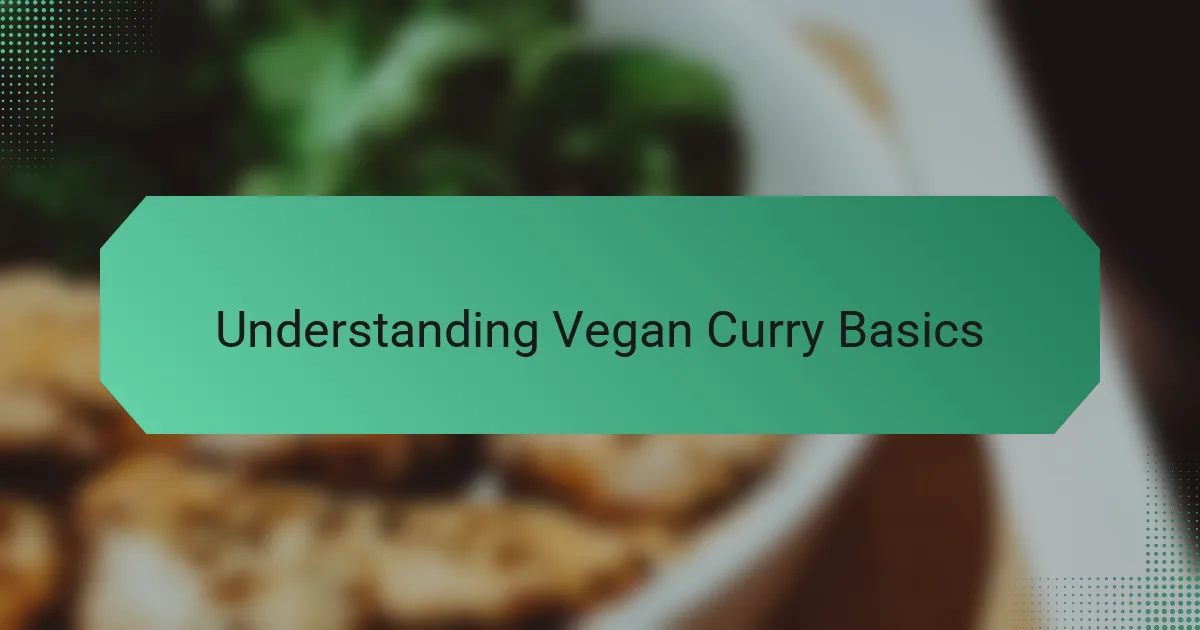
Understanding Vegan Curry Basics
When I first started exploring vegan curries, I realized how essential it is to grasp the basics of flavors and ingredients that make these dishes truly special. Understanding the role of spices like cumin, turmeric, and coriander helped me create a foundation for rich and satisfying curries without relying on animal products. Have you ever noticed how a pinch of turmeric not only adds color but also a warm earthiness that ties the whole dish together?
One thing that surprised me is how versatile plant-based ingredients can be. Lentils, chickpeas, and a variety of vegetables can absorb and complement the curry spices beautifully. I found that balancing acidity, sweetness, and heat is key to keeping a vegan curry from tasting flat, which made me pay closer attention to additions like tamarind, coconut milk, or fresh lime juice.
How do you ensure your vegan curry feels complete? For me, it was about exploring textures and layers of flavor. The right blend of spices combined with creamy elements and hearty veggies can transform a simple pot into something comforting and deeply satisfying — it’s like discovering a whole new world of cooking possibilities.
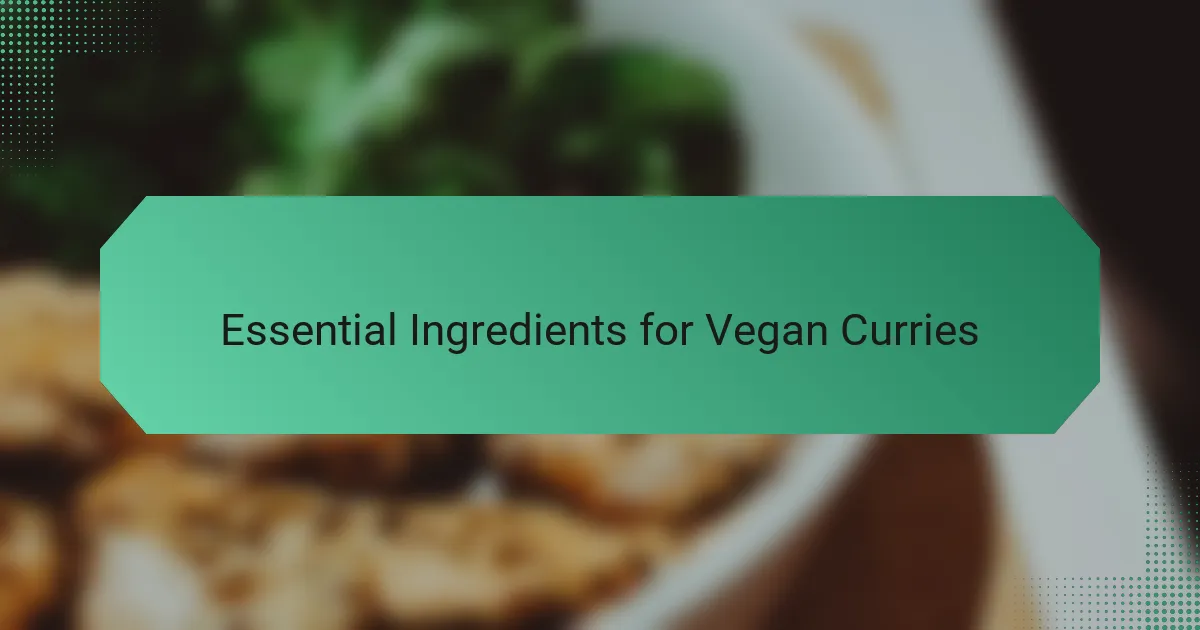
Essential Ingredients for Vegan Curries
When I first gathered ingredients for vegan curries, I quickly realized some staples couldn’t be skipped. Aromatics like onions, garlic, and fresh ginger form the backbone of flavor—they build that warm, inviting base I always crave at the start of cooking. Without them, a curry just feels flat, missing that depth I’ve come to love.
Spices are, of course, the heart of any curry. I often ask myself: which ones will give me the perfect balance today? Cumin, turmeric, coriander, and sometimes a hint of cinnamon or cardamom create that vibrant, layered taste that dances on the palate. Experimenting with different spice mixes has been a joyful journey, each variation telling its own story.
Then there’s the creamy, comforting element that ties everything together—my go-to is coconut milk. It adds richness without heaviness and smooths out fiery heat in a way that feels almost indulgent but totally plant-based. Alongside hearty legumes like chickpeas or lentils, the curry feels nourishing and satisfying, like a warm hug on a cool day. Have you found that one ingredient that makes your vegan curry feel just right? For me, coconut milk is that magic touch every time.
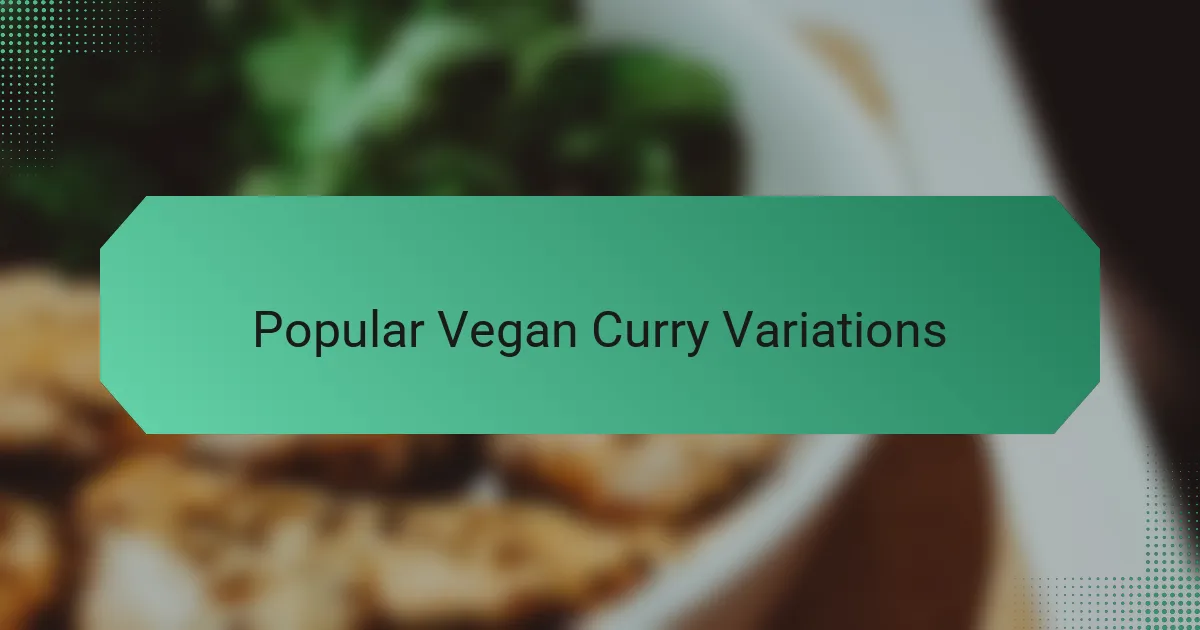
Popular Vegan Curry Variations
One of the vegan curry variations I kept coming back to was the classic chickpea and spinach curry. It’s simple yet packed with flavor, and the chickpeas add such a satisfying bite. Have you ever noticed how the spinach wilts into the sauce, creating this silky texture that makes every spoonful feel like a cozy experience?
Another favorite that surprised me was the Thai-inspired coconut curry with tofu and vegetables. The combination of creamy coconut milk, fresh lime juice, and a touch of chili really woke up my taste buds. I found that swapping out traditional proteins for tofu didn’t just work—it elevated the dish, giving it that perfect balance of tenderness and spice.
Then there’s the lentil dal variation, which quickly became my go-to comfort food. It’s incredible how just a handful of spices can transform humble lentils into something so fragrant and hearty. Have you tried adding a sprinkle of fresh cilantro and a squeeze of lemon right before serving? For me, that final touch boosts the freshness and makes the curry feel complete.
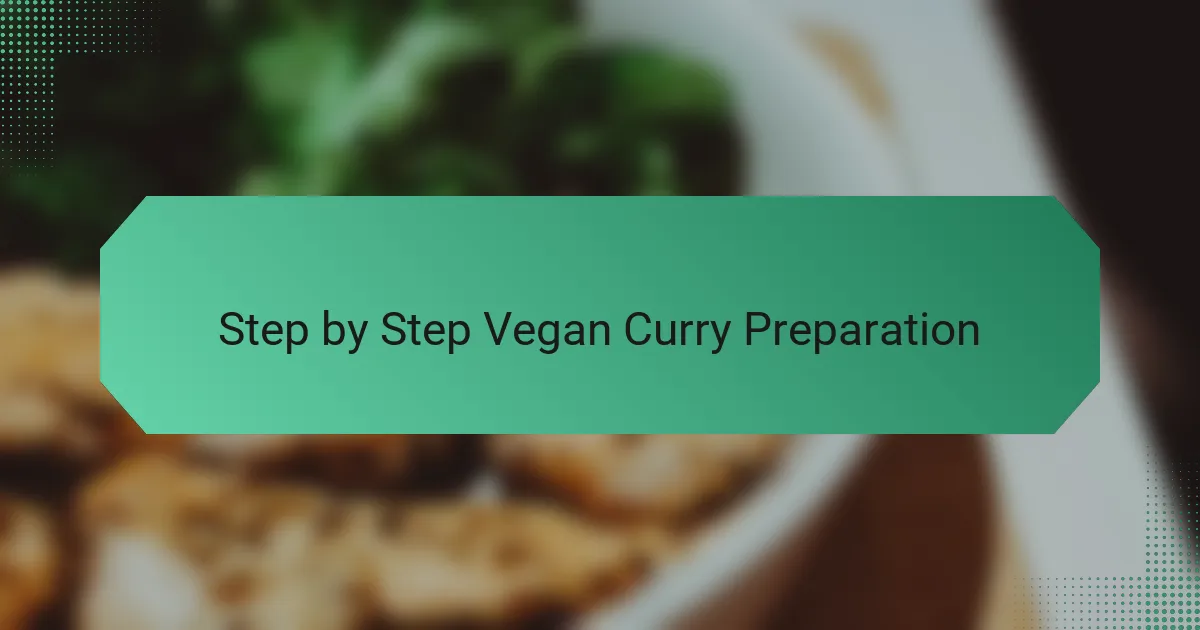
Step by Step Vegan Curry Preparation
The very first step in my vegan curry experiments always begins with toasting the spices gently in a dry pan. Have you ever noticed how this releases their aromas and intensifies flavors? It’s such a small ritual, but it instantly changes the whole cooking experience—almost like welcoming warm friends into your kitchen.
Next, I finely chop the onions, garlic, and ginger, sautéing them until they turn golden and fragrant. This simple step sets the tone and builds a cozy base that makes the curry feel soulful from the very beginning. I learned that rushing this part usually leads to less depth, so patience really pays off here.
When it comes to assembling the curry, I add the vegetables and legumes gradually, allowing each to absorb the spices and develop its own character. Stirring in coconut milk last always feels like the magic moment where everything softens and melds together. Have you felt that creamy transformation? It’s what turns my mix of ingredients into a comforting, nourishing meal every time.
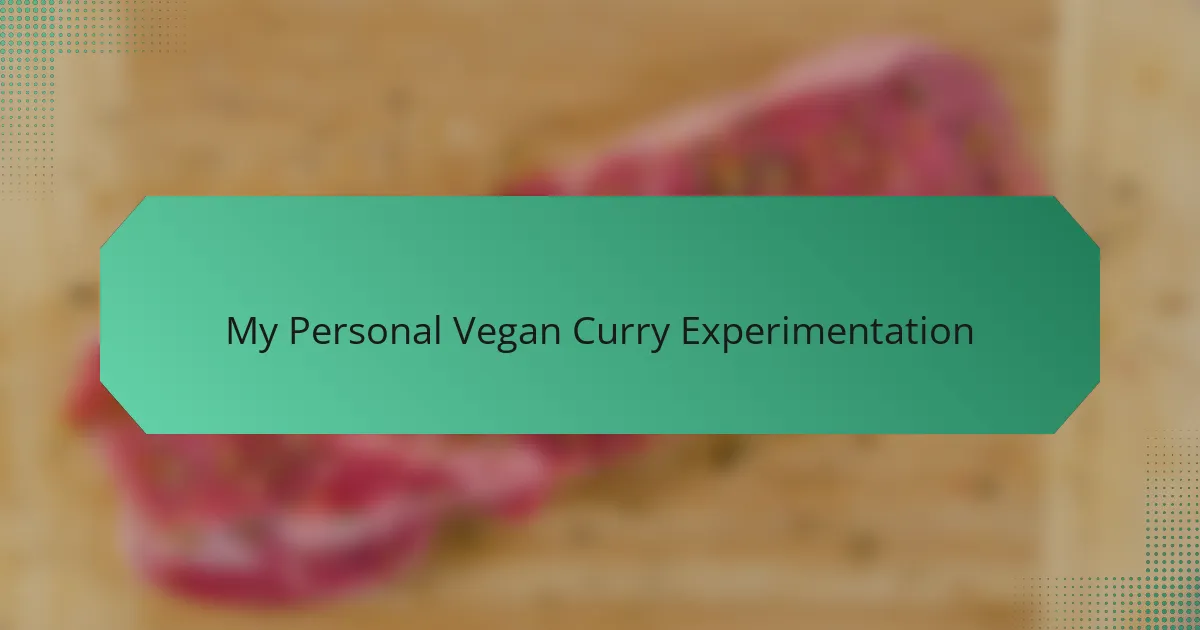
My Personal Vegan Curry Experimentation
Diving into my personal vegan curry experimentation, I found that no two tries felt the same. One day, I’d toss in sweet potatoes for a subtle sweetness, and the next, switch to eggplants to soak up all the spices differently. Have you ever been surprised by how simply changing one vegetable can give a whole new vibe to a familiar dish?
I remember the first time I tried blending cashew cream into a curry instead of coconut milk—initially, I was skeptical. But that creamy, slightly nutty change added a whole new dimension, making the curry feel indulgent yet light. Sometimes, small tweaks like this have made me realize how playful and forgiving vegan cooking can really be.
What intrigued me most was experimenting with spice levels. I often challenged myself to balance the heat so it would awaken my senses without overwhelming them. It made me appreciate the delicate dance of flavors that goes into a curry—it’s not just about spice, it’s about harmony. Has adjusting spice made your cooking more exciting? For me, it sparked a whole new love for crafting layers of taste.
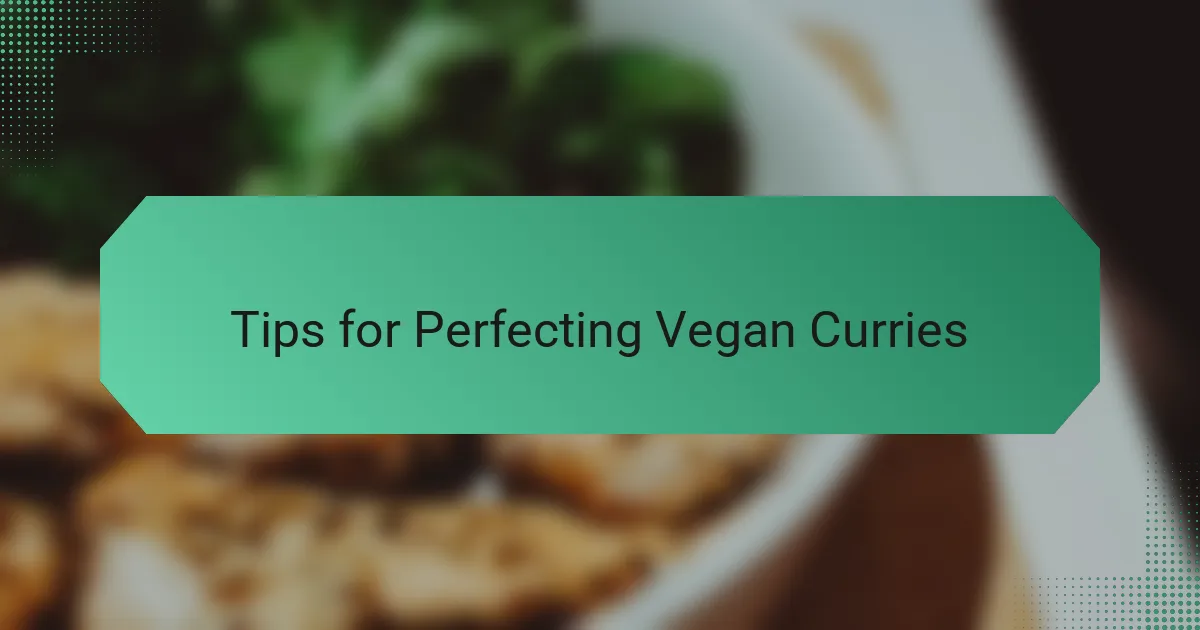
Tips for Perfecting Vegan Curries
One tip that quickly became clear to me is the importance of layering flavors throughout the cooking process. I used to just throw spices in all at once, but now I add them in stages—some toasted at the start, others stirred in later—which creates a depth I hadn’t experienced before. Have you ever noticed how this slow build makes the curry feel richer and more vibrant?
Controlling the heat level took some experimenting as well. I found that balancing spicy, sweet, and tangy notes—not just cranking up the chili—makes a curry truly satisfying. For me, a splash of lime juice at the end often brightens everything up and prevents the flavors from feeling heavy or one-dimensional.
Texture is another game changer. I used to avoid adding nuts or seeds, but mixing in toasted cashews or even a spoonful of almond butter gave my curries an unexpected creaminess and crunch. It’s those little touches that turn a simple curry into something memorable, don’t you think?
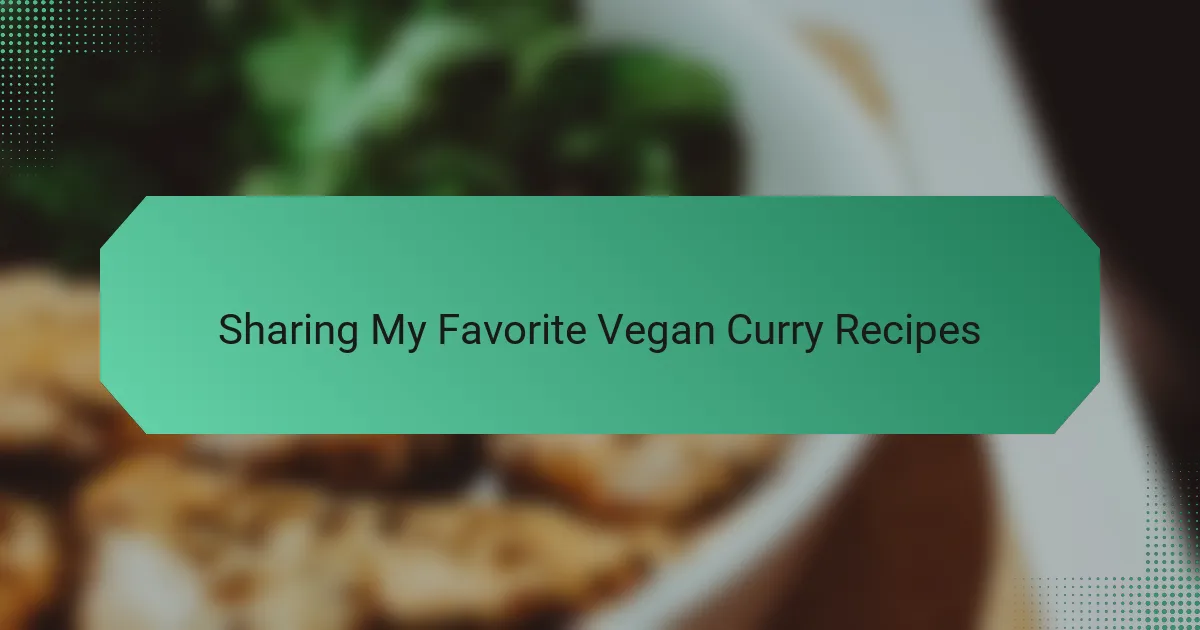
Sharing My Favorite Vegan Curry Recipes
Sharing my favorite vegan curry recipes always brings back memories of those first few tries in the kitchen—some were hits, others taught me valuable lessons. One curry I repeatedly fall in love with features sweet potatoes and chickpeas simmered in a rich coconut-tomato sauce; there’s something deeply comforting about how the sweetness and creaminess meld together that feels like a warm hug on a chilly evening.
I also cherish the vibrant green pea and spinach curry I whipped up one rainy afternoon. The freshness of the peas combined with the earthy spinach and a hint of garam masala created this bright, lively flavor that surprised me with its simplicity and depth. Have you ever experienced that moment when a simple ingredient combo just clicks perfectly?
Finally, the lentil and roasted cauliflower curry remains a staple in my rotation. Roasting the cauliflower to add smokiness before tossing it into the curry gives the dish a satisfying texture and boldness. I find that sharing these recipes is like passing along little pieces of my culinary journey—each one tells a story of discoveries, tweaks, and moments of joy in the kitchen.